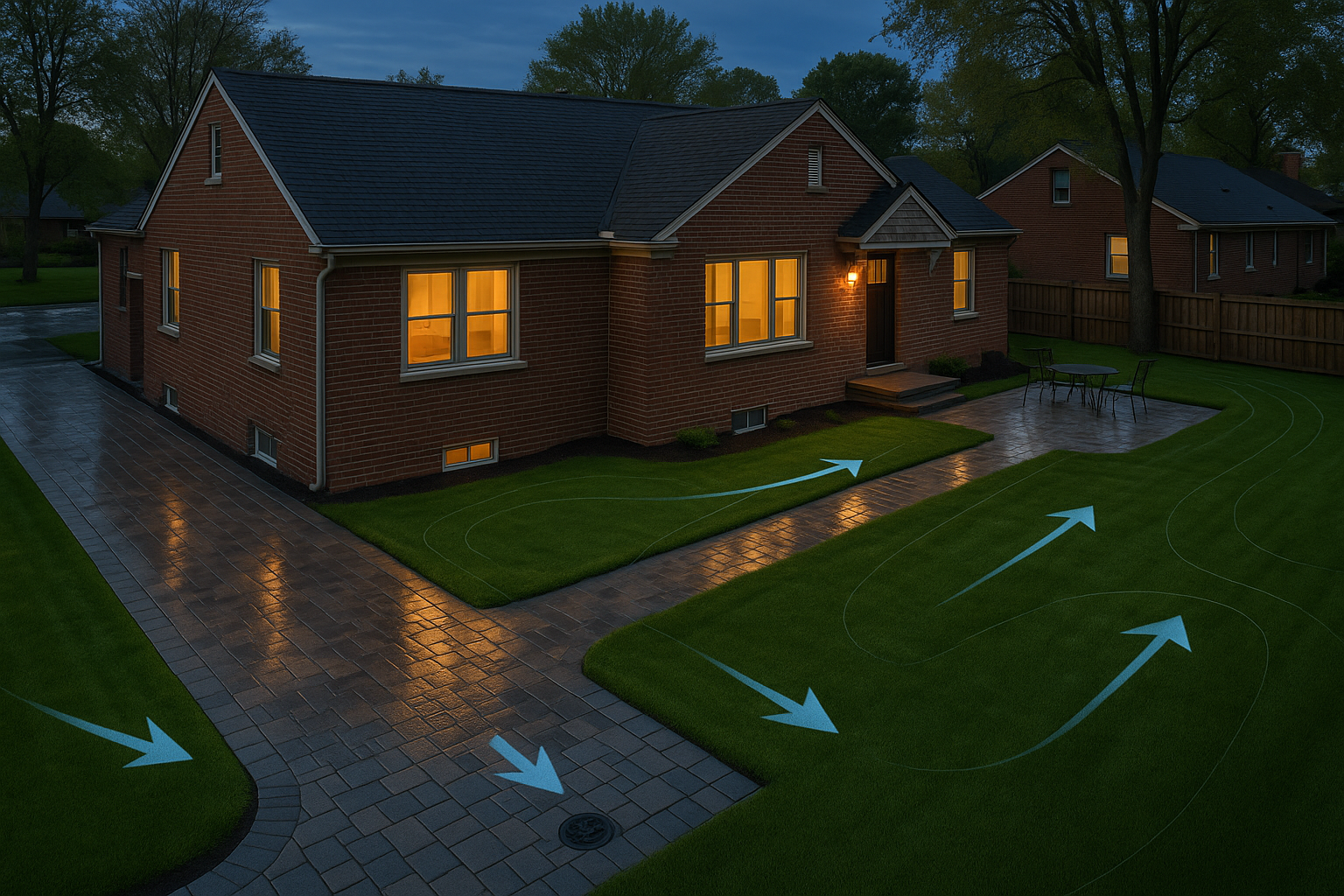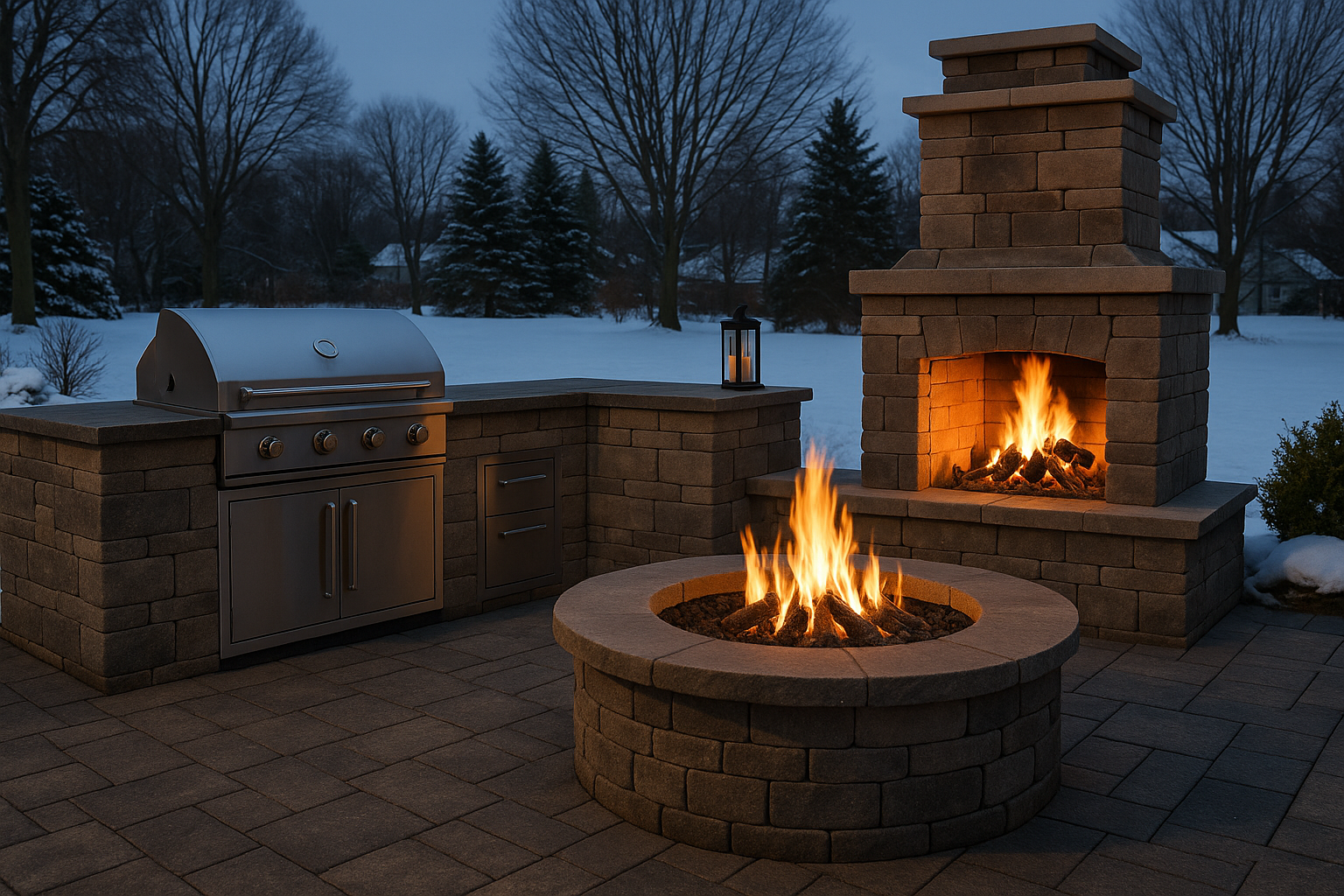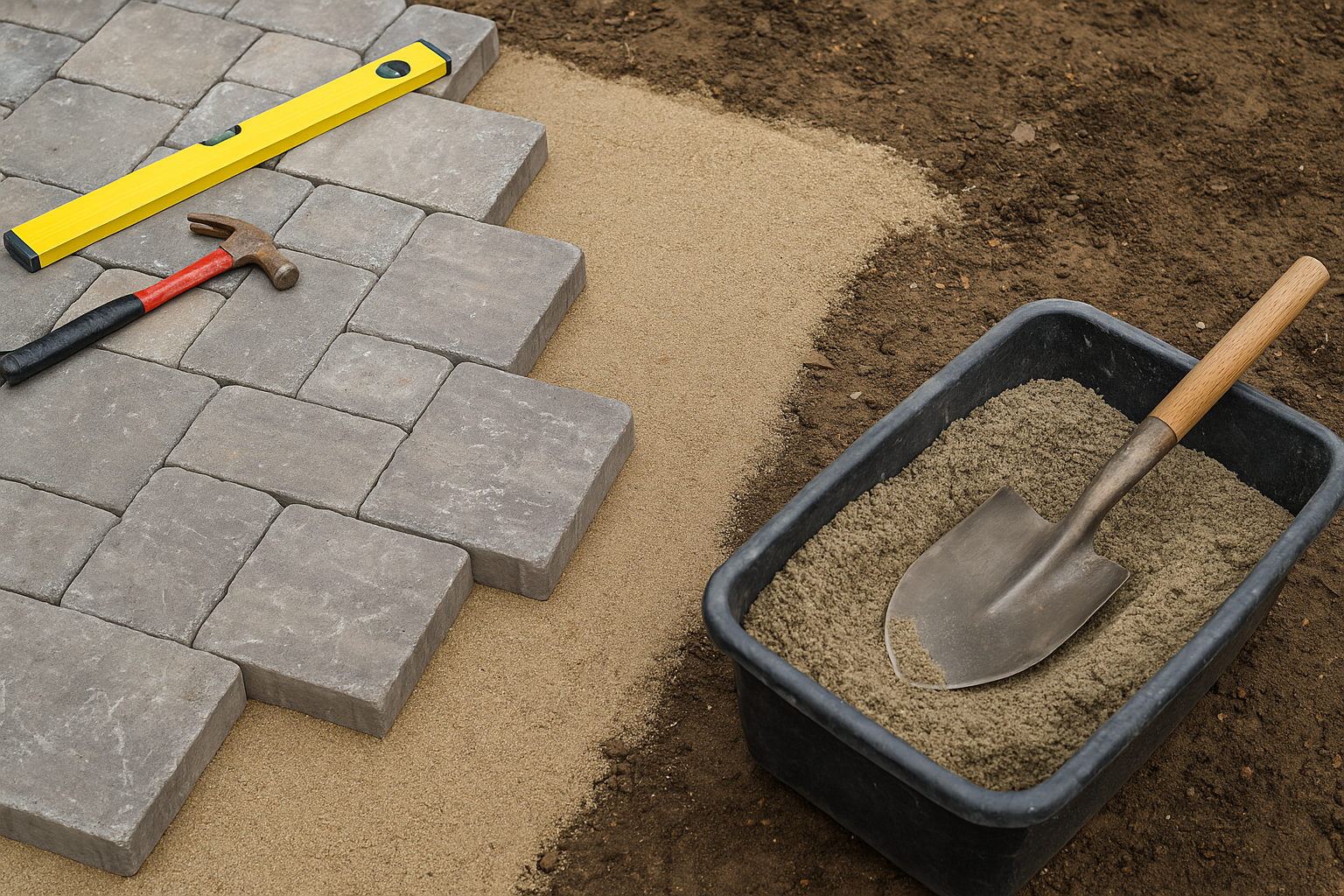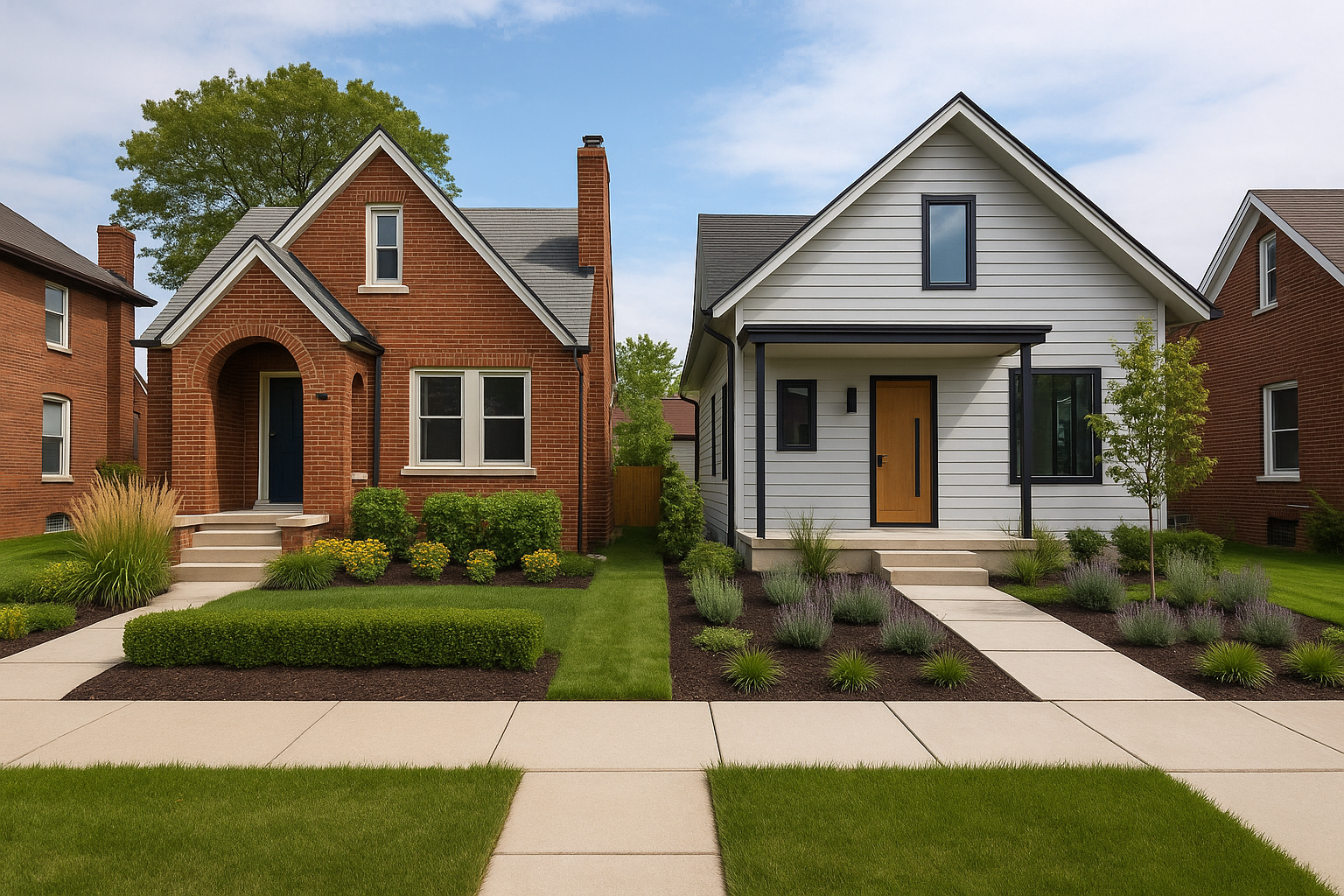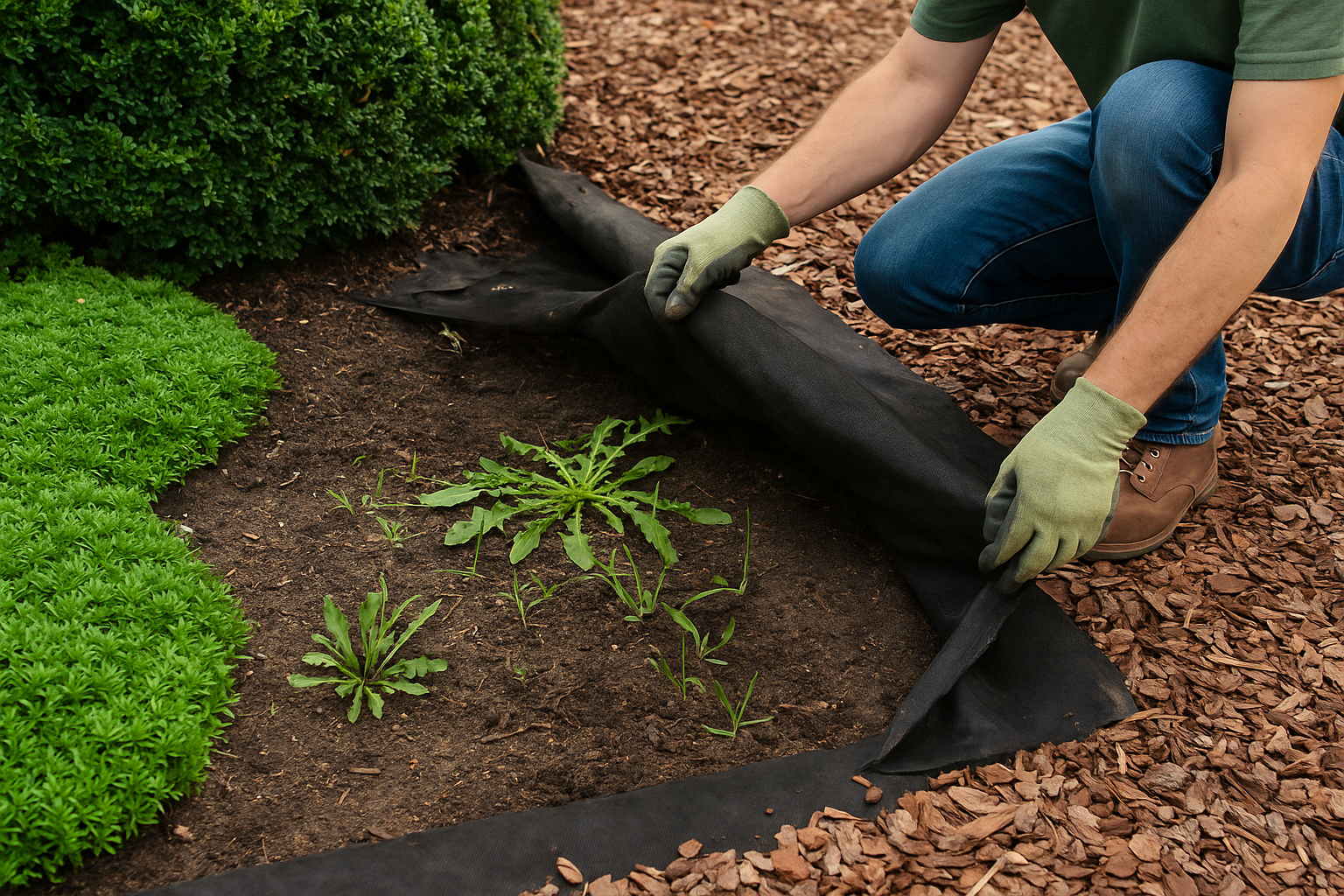The Detroit Paver Driveway and Patio Playbook
If your goal is instant curb appeal that lasts through real winters, focus on the surfaces people touch every day. In this guide we show Detroit homeowners how to specify and build brick paver patios, paver driveways, and stone walkways with bulletproof hardscape design and premium patio construction standards, all tuned to local climate and soil. The result is luxury that reads as architecture, performs under snow and thaw, and raises the bar for detroit landscaping.
What Detroit Weather Demands
Detroit’s climate sets the rules. Average monthly precipitation rises in spring and holds through late summer, then the city enters a true snowy season that peaks in January and February. Plan your work with these rhythms and the build gets easier, the results last longer, and the first winter is uneventful. The National Weather Service normals for Detroit confirm wetter months from April through September, plus average snowfall of roughly fourteen inches in January and twelve and a half in February. Those facts drive staging, access, and protection. National Weather Service
Detroit and many of its suburbs sit in USDA Zone 6b, which influences plantings near paving and guides the shoulder seasons when living edges can be installed without stress. Use the USDA map as your first filter, then dial choices to each microclimate on site. Garden.orgUSDA Plant Hardiness Zone Map
In Detroit, luxury hardscape is not only about the surface. It is about what sits beneath, how water moves, and when the work happens.
The Core Principle
Pavers are your friend in a freeze and thaw city. Interlocking concrete pavers over well engineered base tolerate tiny seasonal movements, and the surface can be serviced without tearing out a giant slab. This is why pavers are used for high value streets and plazas in cold regions. Industry guidance notes that the paver layer does not become brittle in winter and retains stiffness in summer, so temperature swings do not degrade performance when the system is built correctly. Unilock
Step by Step: How to Specify and Build It Right
1. Start with a Detroit specific brief
Before a shovel touches soil, define how the space should live through four seasons. Where will cars turn during a late snow and where will that snow land. How will roof runoff cross a walk. Which sightlines from windows deserve a clean axis of paving. Get these answers first and every selection gets easier.
2. Confirm soils and water
Many Oakland and Wayne County sites have clay rich soils that hold water, compact quickly, and starve roots of oxygen. Clay drains slowly and stores winter water, which pushes hardscapes if the base is wrong. Michigan State University Extension highlights how heavy clay reduces pore space and creates persistent saturation, a known stress on plantings and foundations. Build for that reality by setting finish grades that move water from structures, then add subsurface drainage where needed. Agri College
Salt is another Detroit constant. Winter deicing spray and runoff can burn plants along drives and walks, so plan salt aware plantings and protect the soil with proper edges and drainage. MSU Extension documents how salt spray coats leaves and buds, and how salt in beds near sidewalks and drives accumulates and damages tissue. This is why you specify tolerant species and keep delicate shrubs away from plow paths. Agri College
3. Choose the right system
For hardscape installation in our region, a flexible segmental system is the luxury standard because it is repairable and resilient. ICPI Tech Spec guidance calls for competent subgrade compaction, separation geotextile where needed, properly graded aggregate base in compacted lifts, bedding sand that meets ASTM C33, and a dense paver unit that meets ASTM C936, including resistance to at least fifty freeze thaw cycles. Edge restraints are essential to maintain interlock. These are not nice to haves, they are the foundation of a driveway or terrace that still looks new after ten winters. orco.com
4. Design the base for freeze and thaw
Base depth is not one number. It changes with soil strength, moisture, climate, and loading. ICPI guidance states that residential driveways on well drained soils should have at least six inches of compacted base, while colder climates and weak or wet soils require adding two to four inches or more. Sidewalks and patios need at least four inches on good soils, more when clay and repeated freeze thaw are involved. Add separation geotextile over clay or any subgrade that could pump fines into the base. The cost to deepen and stabilize the base is a fraction of the cost to fix a failed surface. orco.com
5. Control edges and joints
Without edge restraints, pavers can spread under lateral loads and seasonal movement. Tech Spec 3 is clear that edge restraints are required along the perimeter or where materials change. Think curbs, concrete banding, or high strength edge systems set at correct elevations. For joints, premium polymeric sand helps resist washout, weeds, ants, and repeated freeze thaw cycles. Choose a color that blends with the field and inlay tones. Silver Creek StoneworksAlliance Gator
6. Use the calendar as a tool
Detroit’s precipitation and snowfall normals tell you when to push and when to hold. In most years, primary patio and driveway excavation begins after the first real spring dry down. Late summer through early fall is a second window that allows compaction and curing before winter. Protect wet ground from rutting, and keep bedding sand and jointing material dry. Every schedule call should be backed by the local normals. National Weather Service
The Three Big Surfaces
A. paver driveways
A driveway is a working surface and a design statement. Here is the specification playbook.
Structure
• Deepen base in clay sites and at curb cuts where loads concentrate
• Use separation geotextile over clay subgrade to prevent pumping
• Compact in four to six inch lifts to at least the recommended density standards
• Set stable edge restraints, preferably concrete curbs or engineered systems that hold line under lateral tire loads orco.comUnilock
Pattern and scale
• Herringbone patterns distribute wheel loads and resist shear, which is why they are widely recommended for vehicular traffic
• Use ribbon inlays to visually narrow wide drives and to echo window or cornice lines without clutter
• Select a color field that respects the home’s brick or stone and a border that defines edges without reading like stripes Unilock
Winter use
• Specify jointing sands and sealers that tolerate deicing products
• Route snow to landing zones that do not bury plantings, and aim plow edges at seat walls or planters that can take contact
• Site lighting needs to survive shovels and plow spray, so use recessed or protected fixtures rather than exposed bollards
B. brick paver patios
Patios are outdoor rooms. The geometry should read like an extension of the interior floor.
Structure
• Minimum four inch compacted base on good soils, add depth for clay or near large trees where roots move soil
• Use ASTM C33 bedding sand, not stone dust, and never try to correct base irregularities with bedding sand
• Set tight joints, compact, sweep, compact again, and finish with polymeric jointing for a unified surface orco.com
Layout
• Create at least one clear axis from the main door to the view you want to frame
• Use low seat walls to define edges without the visual weight of tall fences
• If you plan to add a kitchen, spa, or pergola later, pre sleeve utilities during patio work
Comfort
• Plan shade for July and late day sun for spring and fall
• Add wind breaks on the northwest if your backyard is exposed
• Place heaters and fire features so heat reaches people without superheating surfaces
C. stone walkways
Walks are the daily touchpoint, so details matter.
Structure
• Match base to site soils and freeze thaw expectations, do not skimp at turns or near downspouts
• Choose texture and micro bevels that read refined but grip in winter
• Use edge restraints or banding to keep lines perfect over time Silver Creek Stoneworks
Experience
• Widen to a minimum of four feet near entries and tight gates
• Add gentle curves that follow planting lines, not serpentine bends that fight the architecture
• Place low glare step lights or integrated cap lights to reduce glare on wet surfaces
Detroit Clay and Drainage: Practical Solutions
Clay is part of life here. It holds water and fights compaction. Plan for it and your hardscape lives longer. MSU Extension explains that clay’s tiny pore spaces drain slowly, reducing oxygen that plants need and creating persistent wet zones that can heave surfaces in winter. That is why you combine smart grading with subsurface drainage. On some sites, flexible drainage strategies such as french drains or even specialty solutions for heavy clays are appropriate, always designed for residential conditions and tied to a legal outlet. Agri College
Rain gardens and bioswales are not only beautiful. The Michigan Department of Environment, Great Lakes, and Energy documents how planted landscape features slow runoff, increase infiltration, and reduce erosion. When designed with clay in mind and sized to local storm patterns, they become luxury amenities that also protect paths and patios. Michigan
Materials That Elevate Architecture
Color and tone
Detroit’s classic brick facades and the clean lines of its mid century and modern homes invite three proven strategies for paver colors.
- Quiet complement
Choose a field that blends with the brick’s body color, then a border a half shade darker to frame edges without a hard stripe. - Warm cool balance
Pair a cool gray field with a warm border that references the masonry, especially on homes with mixed stone and brick. - Modern monochrome
Use one tone in two textures, one smooth and one subtly tumbled, to create depth without visual noise.
Texture and pattern
Large format modules can make small spaces feel expansive. Herringbone patterns shine in driveways. Basket or ashlar patterns can echo historic details without feeling busy. Always test a small area on site to see how light and shadow play on the surface.
Jointing and sealing
Premium polymeric sands help lock joints against washout and movement. Many products are designed to resist freeze thaw and reduce weed and insect intrusion when installed and cured correctly. Use manufacturer instructions to the letter, and keep water off joints until the material is fully set. Alliance Gatorbahlerbrothers.com
Lighting that Works in Long Nights
Detroit’s short days from late fall through winter are another reminder that lighting is part of the build. Grazing light along stone planes, low step lights along walks, and soft uplighting in trees keep the space usable and secure without glare. Map transformer zones so you can shift from entertaining to path finding with a single command. Site fixtures so snow throw and plows do not destroy them.
City Rules You Should Know
Most projects involve simple reviews, but some elements trigger permits. The City of Detroit’s Building Safety Engineering and Environmental Department outlines building permit requirements tied to state codes. Retaining walls over certain heights, larger structures, and other elements often require permits. In local historic districts, the Historic District Commission maintains guidelines for fences, paving, and landscaping that protect district character. Your contractor should manage these steps before mobilizing. City of Detroit+1
Quick Q and A
Do I need a permit for a short garden wall
Small landscape walls may be exempt, but walls that reach common height thresholds usually trigger review. Always confirm scope and address with BSEED before work begins. Motor City Match
What if my home sits in a historic district
Exterior work can require a review to confirm compatible materials and patterns with district character. The HDC publishes guidance for fences, paving, and landscape treatments. City of Detroit
Mini Case: Royal Oak Drive and Terrace
A Royal Oak property had a brick home, a narrow asphalt drive, and a sinking concrete patio. The owners wanted a formal arrival and a versatile terrace that felt like an outdoor room. Soil probes showed heavy clay and a shallow area of persistent moisture near the garage. The Rohto team modeled the site, then rebuilt the driveway with interlocking pavers over a deepened base and separation geotextile. A herringbone field with a subtle ribbon inlay echoed the front facade. At the back, the team removed the slab, corrected grade, installed a french drain tied to a legal outlet, and built a layered patio with a large format field and a smooth border that aligned with the living room picture window. Edge restraints were anchored before bedding sand went down. Joints were compacted, swept, compacted again, then set with premium polymeric sand. Path and step lighting were tucked into capstones. The first winter was uneventful. Snow had clear landing zones, and spring inspection showed tight lines and clean joints. The hardscape felt like part of the house, not an afterthought.
Troubleshooting and Prevention
Heave at the edge of a drive
Likely causes include weak base at the curb cut, missing edge restraint, or poor compaction at transitions. Solution is to reset the area, extend or upgrade the restraint, and increase base thickness. Reference ICPI compaction and edge restraint guidance. orco.comSilver Creek Stoneworks
Wavy patio surface months after install
Often caused by trying to correct an uneven base with bedding sand. Bedding sand is for a one inch leveling course, not for filling low spots. Reset the area and re establish a correct base. orco.com
Joint washout after spring storms
Choose a higher performance polymeric sand and ensure full compaction and cure. Verify that downspouts do not dump onto paving. Product lines designed for erosion resistance and freeze thaw cycles can help. Alliance Gator
Plant burn along walks and drives
Winter salt is a common culprit. Swap to plant friendly traction options where possible, flush beds in spring if site conditions allow, and select tolerant species near plow and spray zones. Agri College
Owner Checklist
Use this quick list to keep your surfaces looking new.
• Confirm soil and drainage plan before you approve final drawings
• Approve base thickness by area, not one number for the whole site
• Require edge restraints at all perimeters and at material changes
• Specify ASTM C33 bedding sand and ASTM C936 paver units for quality assurance
• Use polymeric jointing and protect joints from water until fully cured
• Set lighting that avoids plow damage and glare
• Plan snow storage zones that do not crush plantings
• Schedule a one year walk to adjust lighting, refresh joints if needed, and review drainage
Short Glossary
Bedding sand
The one inch leveling layer over the base. It supports pavers evenly and must meet ASTM C33 gradation. orco.com
Compaction
The process of densifying soils or aggregate base to reach target density for strength and stability. orco.com
Edge restraint
A curb or engineered edge that prevents pavers from spreading and preserves interlock. Silver Creek Stoneworks
Freeze thaw
Seasonal cycle where water in soils freezes, expands, then thaws. Good hardscape systems are designed to tolerate this movement. Unilock
Geotextile
A fabric separator used over weak or fine grained subgrades to keep the base clean and stable. orco.com
Polymeric sand
Jointing sand with binders that locks paver joints and resists washout when installed and cured correctly. Alliance Gator
USDA Zone 6b
Detroit’s general plant hardiness zone, based on average minimum winter temperatures. It guides plant selection and timing. USDA Plant Hardiness Zone Map
Design Moves that Read as Luxury
- Align the paving module with window and door geometry so the patio feels like an extension of the interior
- Use one quiet field plus a single elegant inlay line rather than multiple borders
- Keep stairs wide and shallow for easy movement and add integrated tread lights
- Choose a stone or paver texture that looks refined in bright sun and under snow glare
- Add low seat walls at the edge of drives near shoveling zones, they become both function and form
Why this Playbook Works
It is easy to be dazzled by surface finishes. Lasting luxury comes from engineering and schedule discipline. If your contractor follows ICPI grade compaction and edge restraint guidance, chooses ASTM approved sands and paver units, deepens base for clay and vehicle loads, and respects Detroit’s precipitation and snowfall norms when staging work, the surface stays true and the joints stay tight. That is how you get a driveway that still looks new ten winters from now and a terrace that feels like another room.
Closing Statement
A Detroit hardscape that feels effortless in July and dependable in January is never an accident. It is the result of clear planning, correct base and drainage, careful materials, and a schedule that respects local weather. Choose a builder who treats your driveway, patio, and walks as part of the architecture, and who builds to win against freeze and thaw. If you want the sure path to a beautiful, durable result, Rohto is ready to lead.

